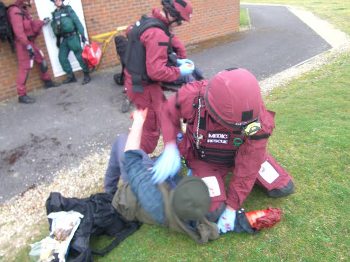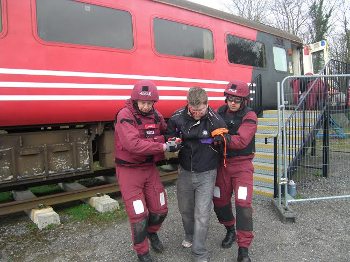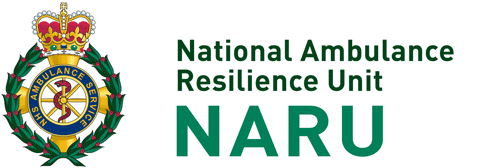The NARU Education Centre delivered a range of challenging clinically-focused exercises under the ‘March Mist’ banner in March 2014, which attracted some excellent feedback from those who attended.
Group Commander Andy Peckham, Response Support Manager at Bedfordshire Fire & Rescue Service summarises the event:
“Eight Fire and Rescue Services attended the National Ambulance Resilience Unit (NARU) at Winterbourne Gunner over two days on 11 and 13 March. Working alongside Ambulance colleagues, fire-fighters were asked to manage a range of complex trauma scenarios based on potential firearms-related injuries.
“Exercise ‘March Mist’ was developed and delivered by NARU to assess the potential skill fade levels of responders, following the initial tranche of medical up-skilling to support a response to an MTFA incident 24 months ago. On 13 March, two Special Operations Team members from each of Bedfordshire, West Yorkshire, West Midlands and Essex Fire and Rescue Services took part in three realistic scenarios.
 “On each scenario, an Ambulance lead medic was deployed within a team to provide casualty triage and medical lead, however all the fire-fighters were required to respond effectively to time critical, multiple casualties presenting a range of injury type; from airway complications to gun-shot wounds, blast injuries and loss of limbs, then provide effective extrication to a clearing area.
“On each scenario, an Ambulance lead medic was deployed within a team to provide casualty triage and medical lead, however all the fire-fighters were required to respond effectively to time critical, multiple casualties presenting a range of injury type; from airway complications to gun-shot wounds, blast injuries and loss of limbs, then provide effective extrication to a clearing area.
“The first two scenarios were created within former military buildings and included up to 20 casualties, with the fire-fighters and Ambulance personnel split into two teams. A significant number of the casualties were provided using ‘Amputees in Action’, who were able to provide both visual and emotive challenge as well as some excellent feedback on the care received. The enclosed spaces and various rooms, together with the shouts and screams from the role-players, all added to increase the pressure.
“The third scenario was a rail incident, bringing the fire-fighters together to manage a large number of casualties in a very limited space. To further complicate the situation, the teams were asked to manage a range of injury types with the added pressure of noise distractions, including piped-in baby cries and loud music.
 “Overview to each scenario was by representatives for Department of Health, Home Office and Fire and Rescue. All were impressed by the joint working performance of all those personnel involved, the commitment demonstrated and the reality of the scenarios that had been created.
“Overview to each scenario was by representatives for Department of Health, Home Office and Fire and Rescue. All were impressed by the joint working performance of all those personnel involved, the commitment demonstrated and the reality of the scenarios that had been created.
“During the debrief all the fire-fighters commented on how beneficial this experience had been for them; the reality of the injuries and pressure of working in demanding situations. All also commented on the excellent work by NARU on hosting and running the scenarios and requested more of a similar nature.
“The outcomes of the scenarios will be used to inform future training materials to support the 15 current Fire and Rescue Services with an MTFA response capability. Whilst individual fire and rescue services will have sourced refresher training opportunities and joint exercising with their colleagues within Ambulance and Police, it is widely recognised that there needs to be some over-arching guidance on what needs to be included and support to enable this type of realism to be delivered periodically to larger numbers of specialist responders that each Service maintains.
“I would like to offer my personal thanks to NARU for hosting an excellent event and giving me the opportunity to witness and comment on the activities during the course of the day.”
The Fire and Rescue Service’s appreciation of the day was shared by Fraser Rowbotham, HEMS Team Leader at South Central Ambulance Service, who said:
“Last week saw several exercises at NARU, involving intervention team staff working alongside staff from the fire service on a national level. The purpose of the training was to reflect on how well we work together as a team, with particular attention towards the fire service first responders.
“We were faced with several high impact scenarios which were designed to push our skill sets and clinical decision process alongside dynamic triage and treatments. Throughout the day’s events we were able to debrief and conduct “lessons learnt” debates, which form a valuable basis that can only be achieved by actively exercising at such a demanding level.
 “The value of exercises is a vital tool in team working and dynamic decision processes. Staff were able to conduct robust treatments on actors and Amputees in Action, which again provide a sense of realism which you only get in training. The surroundings in which the exercises were formed also played a part in providing challenges in buildings and areas and confined spaces, such as railway carriages.
“The value of exercises is a vital tool in team working and dynamic decision processes. Staff were able to conduct robust treatments on actors and Amputees in Action, which again provide a sense of realism which you only get in training. The surroundings in which the exercises were formed also played a part in providing challenges in buildings and areas and confined spaces, such as railway carriages.
“The clinical value of such training holds no boundaries. We all experienced a high level of clinical input and treatments protocols. This showed the strengths and weaknesses of each team, again this can only be achieved by exercises.”
For more details about NARU exercises, contact nicola.harrington@wmas.nhs.uk
